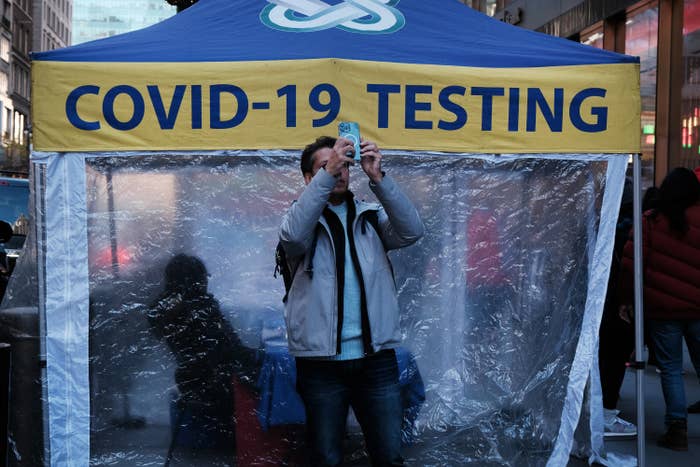
In May 2023, the Biden administration will end the COVID pandemic’s status as both a national and a public health emergency, which were declared three years ago. The move revamps the federal pandemic response in ways that could limit Americans’ access to lifesaving treatments, tests, and other COVID-related healthcare.
Most people will still have free access to COVID vaccines, including boosters, even after the public health emergency status is gone.
However, you may have to pay for all or a portion of your COVID tests and treatments, depending on whether you’re insured and the type of coverage you have.
Even with some protections in place, you could still experience issues accessing COVID vaccines, tests, and treatments because the government will no longer control the supplies. So if your pharmacy doesn’t order sufficient supplies — or if the manufacturers don’t produce enough — you may have to wait until the stock replenishes, which for some people could be life-threatening.
People who are not insured will lose virtually all guaranteed access to COVID tests, vaccines, and treatments.
The Biden administration’s decision, effective May 11, comes just three days after House Republicans announced they will vote on immediately ending both emergency declarations, which the president said “would be a grave disservice to the American people.”
An abrupt end to the declarations could strip tens of millions of people in the US of their health insurance and remove billions of dollars in state Medicaid funding, the administration’s Office of Management and Budget said in a Jan. 30 statement. (Medicaid provides medical coverage via federal and state funding to individuals and families with low incomes.)
“In December, Congress enacted an orderly wind-down of these rules to ensure that patients did not lose access to care unpredictably and that state budgets don’t face a radical cliff,” the administration said. “If the PHE were suddenly terminated, it would sow confusion and chaos into this critical wind-down.”
The sudden change could also lead to disruptions in care and payment delays as hospitals and nursing homes that relied on the flexibilities offered by the emergency declarations will have to quickly create new billing processes. People who use telehealth could lose access to clinical services and medications too, the administration said.
This is why the Biden administration scheduled the declarations’ expiration in May, to allow time for people and healthcare systems to adjust.
Still, House Majority Leader Steve Scalise said it’s not worth waiting until May to end the declarations, adding that “the vast majority of Americans have returned to work and resumed their lives months ago.”
“House Republicans are making it clear that the days of the Biden Administration being able to hide behind COVID to waste billions of taxpayer dollars on their unrelated, radical agenda are over,” Scalise said in a statement posted Monday.
COVID continues to kill about 500 people in the US every day, especially older and immunocompromised adults, even as cases and hospitalizations have decreased in recent weeks. Meanwhile, tens of thousands of people are experiencing lingering symptoms after infection known as long COVID, and those with weakened immune systems are forced to find ways to protect themselves as most COVID precautions have been lifted.
Here are the changes that may impact you most as the COVID pandemic lingers on.
You may have to pay for COVID tests
The current public health emergency status requires private insurance companies to cover up to eight at-home COVID tests per month per person, as well as any test (PCR or rapid) a doctor or clinic gives you, regardless of whether it’s in network — with some minor exceptions and only after a rather tedious reimbursement process.
But after May, you might have to pay part of or the full price for COVID tests, depending on how your insurer decides to cover them.
For example, your insurance company may choose to cover just one test a month and you’ll be responsible for paying for part or all of additional tests; it may decide to cover your tests only at in-network providers or pharmacies; it can implement copays for tests or charge deductibles; or it can continue to cover all of your tests at no cost to you — “but that seems unlikely,” according to Cynthia Cox, vice president of the Kaiser Family Foundation, a nonprofit focusing on national health issues.
That’s why it’s going to be extra important to communicate with your insurance company.
“Call ahead and find out what the cost is at each place you plan to take a test at because we've seen some cases where the price of a COVID test could be hundreds of dollars and other cases tens of dollars,” said Cox, who conducts economic and policy research on the Affordable Care Act and its effects on private insurers. “Understand your coverage, understand what your insurer is doing, and then possibly shop around if you're not sure how much it's going to cost you.”
Medicare — federal health insurance for people aged 65 and older — will no longer cover the full cost of at-home COVID tests, which the AARP cites as a main reason why it opposes ending the public health emergency status. (Tests issued by medical providers will be covered.)
“The PHE should continue until cases have been reduced and there is an orderly transition in place to ensure all Americans can get the care they need,” the association said in a statement sent to Congress on Tuesday. “Older Americans rely on programs and flexibilities authorized under the PHE to keep them safe, such as Medicare coverage of at-home COVID tests and coverage of certain treatments. Their health and well-being should be valued as much as Americans of any other age group.”
If you’re enrolled in Medicaid or the Children’s Health Insurance Program, your COVID tests will still be covered, including at-home tests, until around May 2024, according to the Kaiser Family Foundation. After that, you may have to pay some of the costs.
If you don’t have health insurance, you will no longer be able to access free COVID tests via the “Medicaid eligibility pathway” that the public health emergency introduced.
Reduced access to COVID tests could mean fewer tests are taken even as the coronavirus continues to spread, and also may prevent people from getting needed treatment. (Paxlovid, for instance, must be taken as soon after a COVID diagnosis and within five days after symptoms started.)
Testing your child every day to ensure their infection is over before sending them back to school can protect other kids from getting sick, Cox said. But if you had to pay a lot of money for each test, some parents may not want or be able to take those precautions.
The same thinking applies to accessing treatment, Cox added. “If people are not able to access the tests that they need to determine if they have COVID and then start Paxlovid quickly, then they might not be able to get that treatment, which could lead to a worse health outcome or need for hospitalization that they otherwise wouldn't have had — and then be stuck with even greater costs,” she said.
You may have to cover treatment costs, too
When it comes to COVID treatments, people with Medicare or no insurance at all will face the biggest changes after May, according to Cox.
Medicare enrollees currently pay nothing for COVID treatments, including monoclonal antibody infusions and oral antivirals like Paxlovid. (Technically, no one has to pay for Paxlovid because there are still federally purchased doses available for free.) After May, that will no longer be the case. Some people with Medicare might have to pay a portion of their treatment costs once the federal supply runs out.
If you don’t have insurance, you will have to pay for any COVID treatments you may need (if you weren’t already paying for them because of the Medicaid eligibility pathway) when federal supplies run out.
If you have Medicaid, your COVID treatment services will still be covered until around May 2024 (then you may face cost-sharing). However, if at that point some treatments like Paxlovid are still under emergency use authorization, which experts don’t believe will be the case, then each state will have to decide if they will cover the costs or not.
Americans with private insurance who need COVID treatment will be responsible for paying for whatever their insurer doesn’t cover, but they can still get free treatments as long as the supplies purchased by the federal government last.
Vaccines are still free for everyone…for now
All COVID vaccines and boosters administered so far have been purchased by the federal government, so they’ve been free for everyone, regardless of insurance — and this will continue to be the case even after the public health emergency expires.
That is until the free doses run out, but Cox said she doesn’t think that’s going to happen anytime soon because Americans have been slow to roll up their sleeves; about 69% of the population has been vaccinated with two doses and just 15.5% with the updated bivalent booster.
Pfizer said that consumers could pay anywhere between $110 and $130 per dose of its vaccine. Moderna said it would charge between $64 and $100 per dose. That’s three to four times more expensive than what the government paid and not particularly good news for the uninsured, given the FDA suggested most people should receive one COVID shot a year, similar to flu vaccination.
Most people with private insurance can get free vaccines after the federal supply runs out, "but there could be some uncommon exceptions," Cox said. Just make sure that the clinic or provider you visit is in-network with your insurance.
If you are on a Medicaid or CHIP program, your COVID shot and administration is considered a mandatory benefit that will be covered.
Medicare will also pay for your vaccine and administration after the free doses run out.
If you don’t have insurance, you may be able to find a free COVID vaccine through a community health center. Otherwise, you’ll have to pay full price.
Telemedicine will be limited for some people
The public health emergency introduced many telemedicine flexibilities during the pandemic, most of which have been extended until the end of next year, but some will expire after May.
Some providers will no longer be able to prescribe controlled substances like pain medications through a telemedicine appointment, according to Cox. After May, some patients may have to see their provider in person first.
And depending on the state you live in, you may not be able to meet with a specific medical provider via telemedicine if they practice in a different state after the public health emergency expires.
